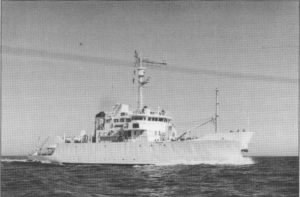- Author
- Cheverton, N., Lieutenant, RAN
- Subjects
- Ship histories and stories
- Tags
-
- RAN Ships
- HMAS Flinders
- Publication
- March 1999 edition of the Naval Historical Review (all rights reserved)

At 1430 on the 12th October 1998, the Australian -White Ensign was lowered for the final time in the Royal Australian Navy’s Hydrographic Survey Vessel, HMAS Flinders.
Flinders had served Australia for just over 25 years, travelling some 553,441 nautical miles and spending 55,646 hours underway. She conducted in excess of 180 Hydrographic Instructions issued by the Australian Hydrographic Office and was part of the team responsible for the charting of one seventh of the worlds oceans. It is estimated over 1800 personnel served in Flinders, including 15 separate Commanding Officers.
It is a pretty impressive set of statistics that make up the final figures for HMAS Flinders but what of the ship herself. Flinders was built in 1972 at Williamstown Dockyards in Melbourne. She was to be unique, with no sister ships in the Royal Australian Navy. A vessel of similar design was built for the Philippines and named Atyimba but it lasted some fifteen years before being scrapped. Flinders was to survive a further 10 years and was still in great condition when she was decommissioned from Naval Service. She was the latest in technology with her all-weld design, bulbous bow and a very low quarterdeck area that would enable her to conduct operations in all weathers and in every corner of the Australian continent.
Unique is the only way to describe Flinders. Her high forecastle area and low quarterdeck meant that all usual shiphandling rules for twin screwed vessels went out the door. She did what she wanted, when she wanted. It took a good sailor to drive Flinders, someone who knew her and what she wanted to do. To serve in her was to love her because she was solid in a blow or heavy sea state, reliable and as a testament to those who served in her, never involved in a collision or grounding. This despite the fact that she was based all her life in one of Australia’s tightest transit routes through the Great Barrier Reef and operated primarily in uncharted waters. Her job was to find the hazards and make sure no one else found them, the hard way.
Hydrographic operations can take their toll on a ship and Flinders spent a lot of time at sea, away from support or any other naval units. Operating in some of the most remote locations in Australia, from King Island off Tasmania to many seasons off Arnhem Land, the North West of Western Australia and the place that was her home, the Great Barrier Reef. It was here in 1974 that she discovered the route that was to become known as Hydrographers Passage. A break in the reef that would cut in excess of 250 nautical miles off the trip between Gladstone/Mackay and Korea and Japan, this passage has saved many millions of dollars and caused more than just one grey hair for her Commanding Officer and crew at the time.
But Hydrographic and Oceanographic operations were not the only responsibility of Flinders. She was the first ship into Darwin after Cyclone Tracy, declaring the harbour safe for the entry of other shipping in support of the disaster relief. Sailing from Cairns, where her crew were enjoying a well deserved Christmas break, as soon as it became apparent she was needed, Flinders arrived off a ravaged Darwin on 26 December 1974. She then remained in the area providing support until 12 January 1975. Disaster relief is a large responsibility of today’s RAN and Flinders made her very real contribution count.
Flinders was also a policeman and surveillance unit, when in 1978 she was involved in the capture of Australia’s then largest drug bust in the Calualdos Islands/Pockington Reef area of North Queensland. She unloaded the seized contraband in Townsville on 21 June 1978 and straight away returned to her survey task. It was this ability to conduct a variety of operations that kept her viable for so long. The reason she left naval service was because technology had overtaken her, not because she was no longer needed.
But surveying the uncharted waters of Australia and the world were the primary responsibility of HMAS Flinders. Like the surveyor and explorer she was named after, Flinders worked until her end. Her final survey took place in the Whitsunday Island Group, just off Hayman Island where on 26 August 1998, she ran her final survey line. She then returned to Cairns and the white ensign was lowered for the final time in front of the Maritime Commander, RADM C. Ritchie and her crew marched off for the final time. It was perhaps the proudest and also one of the saddest moments of her career. .A career that spanned 25 years of service to the RAN.




